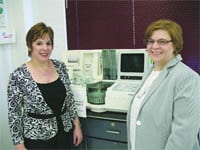Fluid Opportunities STCC’s Laboratory Science Program Helps Meet a Critical Need
Susan Schneider describes them as “people who like to solve mysteries, people who want to look at clues and come to an answer.”
She was referring to medical laboratory technicians, and explaining that there is no mystery about the opportunities currently available in this behind-the-scenes, but critically important, medical specialty.
“The fact is, a lab is very stable place to work,” said Schneider, who chairs the Clinical Laboratory Science department at Springfield Technical Community College. STCC offers an intensive, two-year track for students who seek certification to work in a clinical-laboratory setting — a program that’s growing in popularity as a national and regional shortage of lab workers gains more media attention.
In fact, according to the U.S. Bureau of Labor Statistics, with the workforce rapidly aging, some 10,000 new clinical laboratory scientists and technicians will be needed per year over the next 10 years, but fewer than 5,000 are graduating from laboratory-science programs annually.
“At a time when health care consumes more than 16{06cf2b9696b159f874511d23dbc893eb1ac83014175ed30550cfff22781411e5} of the country’s GDP, clinical laboratories provide a significant level of value — contributing up to 70{06cf2b9696b159f874511d23dbc893eb1ac83014175ed30550cfff22781411e5} of the objective information used to make key medical decisions, while comprising less than 5{06cf2b9696b159f874511d23dbc893eb1ac83014175ed30550cfff22781411e5} of a typical hospital budget,” said Joeline Davidson, spokesperson for the Clinical Laboratory Improvement Advisory Committee (CLIAC), which recently held a two-day symposium on laboratory workforce issues.
“We recognize that, without a resolution, the workforce shortage could threaten the clinical and economic outcomes of health care consumers,” she added. “This is one reason we are committed to educating people about the importance of clinical laboratory professionals and developing effective recruitment efforts to encourage younger generations to join the career field.”
That’s also why STCC’s program is important to the Western Mass. region — it supports the needs of the area’s hospitals and health systems, which generally report difficulty in filling laboratory needs, by keeping those promising mystery-solvers in the region.
Echoing Davidson’s statistic about 70{06cf2b9696b159f874511d23dbc893eb1ac83014175ed30550cfff22781411e5} of all hospital patients needing some kind of lab work, Schneider said few areas of a medical practice are as critical to positive outcomes as the laboratory. In addition, “if you go to the doctor, they often won’t diagnose you until they get the lab results back after blood is drawn.”
Yet, she noted, “it’s the least hands-on of all health care careers, so it’s ideal for people who are very analytical and want to help people, but don’t necessarily want a lot of patient contact.”
Down to a Science
STCC offers a one-year certificate program that allows graduates to work as a clinical laboratory assistant, in addition to its two-year associate degree program, from which graduates can be tested to earn national certification as a lab technician.
It’s not a track for the faint-hearted, said Schneider, noting that a wide swath of material is condensed into three semesters, including courses in hematology and coagulation, chemistry, microbiology, blood bank, medical immunology, urinalysis and the study of other fluids, and quality management in the lab. The fourth semester is dedicated to gaining experience in a clinical lab setting.
STCC used to take new students into its Laboratory Science programs every other year, but it has moved to annual enrollments, reflecting a growing awareness of the need for more lab workers. The first graduating class totaled just four, but the college sent off 12, 10, and nine the past three years, and 14 will graduate next year.
Graduates are clearly benefiting from the nationwide shortage, reasons for which vary. Writing in Medical Laboratory Observer, Roger Beckering observed that average wages, nationally, haven’t kept pace with other allied health professions. At the same time, shortages in many institutions cause the remaining workforce to have to carry out the same volume of tests as a fully-staffed lab, leading to exhaustion, burnout, and increased potential for error.
Then there’s the simple matter of demographics. “In most institutions,” Beckering noted, “the aging laboratory workforce is a great concern. The Baby Boom generation is nearing retirement age, which will affect the shortage in three ways: by expanding the demand for health care, by causing a huge loss of experience, and by increasing the shortage of laboratory professionals.”
Beckering suggested that, as the “hidden profession” in health care, laboratory science doesn’t allow technicians to be recognized for their role in patient specimen collection and processing, which can be a negative when it comes to job satisfaction.
But Schneider said lab work itself can be attractive to a wide range of people — particularly those who completed undergraduate degrees in fields like chemistry, biology, and microbiology — and the stability of the career is enough to push many to pursue it as a second career.
On top of that job security, many employers are presenting incentives, including student-loan forgiveness in exchange for a commitment of service. “Our students are being actively recruited from as far as Vermont and Maine,” said Carolyn Kozlak, an instructor in the STCC program.
By some estimates, 60{06cf2b9696b159f874511d23dbc893eb1ac83014175ed30550cfff22781411e5} of the clinical-laboratory workforce will leave the profession over the next five to 10 years, Schneider told The Healthcare News. “That’s huge. And because of that, none of our students have any problems getting jobs.”



Comments are closed.